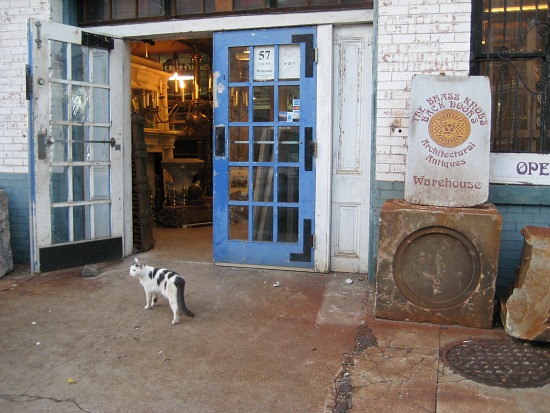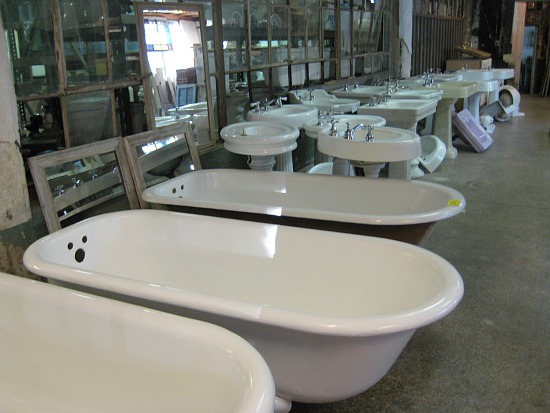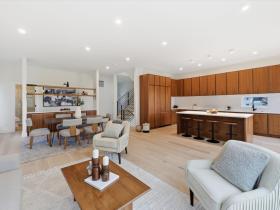 The End of an Era at The Brass Knob
The End of an Era at The Brass Knob
✉️ Want to forward this article? Click here.

Entrance to the Brass Knob Warehouse
Think of it as a Victorian Home Depot.
The Brass Knob Back Doors Warehouse at 57 N Street NW (map) has all the same stuff as its big box cousin, except the merchandise is older—we’re talking 60, 80, even 100 years old — and more authentic. And that’s what its fans love about it.
“Part of it is the mystery of just walking through the aisles,” said James Fournier, explaining what attracts him to the N Street warehouse located just west of North Capitol Street. Over the past 11 years, Fournier has renovated his Bloomingdale row house using almost entirely Brass Knob merchandise: decorative radiators, pier mirrors, mantels, wood trim, tin ceiling panels. “I always end up getting something there,” he said. “Whether it’s what I need or not.”
But Fournier and his fellow architectural salvage buffs are going to have to find a new way to get their fix: the cluttered 24,000 square-foot warehouse has announced it will close by the end of the month. Rent and taxes are high and business has been down for the past year, said owner Ron Allan, who’s run the Brass Knob Back Doors Warehouse for three decades. Lately he’s been keeping the doors open largely as a labor of love.
“I can’t bear to see things thrown away when they have intrinsic value,” said Allan, who lives in Mount Pleasant in a home built in 1918. “I know how important it is to have materials that are compatible [when you’re restoring an old house].”
In the 1970s, Allan worked for the physical plant and planning departments at George Washington University. He remembers hearing that the apartment building he lived in (a brick, turreted building where GW’s hospital is now located on Washington Circle) was going to be torn down to make way for the expanding university, and was determined to get the doorknob off of his door and save it. He got it, and eventually started scrounging for other stuff; along the way, he got to know the demolition companies in the city and began collecting castoff items from old homes. In 1981, he and his then-partner opened Brass Knob Architectural Antiques in Adams Morgan; the two split amicably in 1991, when Allan opened the warehouse.

There’s a lot to choose from at the warehouse. New truckloads of materials arrive at the store daily, sold by contractors working in neighborhoods ranging from LeDroit Park to Chevy Chase, whose clients are more interested in upgrading old features than burnishing them.
Shopping at the Brass Knob is like shopping at any other thrift store: customers trade low prices and the possibility of finding treasures for the time and energy involved in the search. Items are organized—to a point. Someone seeking a particular panel door (average price: $45) might have to look through the hundreds stacked next to each other in order to find the right one. Porcelain sink fixtures are available ($18 for a complete set), but you’ll have to sort through a drawer of various sized faucet handles to find one that fits. The store’s dusty mazes hold many more surprises: curlicued iron gates and grates begging to be reinvented; clawfoot tubs; perfect pedestal sinks; engraved brass hinges; leaded windows; and even portly wood columns.
For die-hard customers who swear by the quality and detail in old architectural elements, all the effort is worth it.
“This is a repository—I’m here all the time,” said Sarah Rispin, who lives in a home on R Street NE that was built in 1907. Standing at the checkout counter, she can’t stop herself from giving a brief lecture about the unparalleled quality of older home features and the benefits of the Brass Knob. “They’ve got pocket doors here that are eight feet wide, 16 feet tall—you’ll never find them anywhere else. There’s no other resource like this.”

The many tubs available at the warehouse
Unfortunately for many of DC’s homeowners, Rispin is right. Community Forklift in Hyattsville comes the closest; the nonprofit organization’s huge warehouse holds a variety of recycled building elements, but they’re from pretty much any era, so someone seeking to restore a Victorian rowhouse might be out of luck. Allan will be transferring whatever is left of his stock to Community Forklift, though, so the Hyattsville store may have historical pieces for a while.
Baltimore has two architectural salvage shops: Second Chance and Housewerks. But neither one is quite like the Brass Knob; the former has all kinds of building materials, and the latter is semi-rarified, more like an antique store than the rough-and-tumble Brass Knob.
The Washington institution’s fans sigh that they will soon be resigned to searching Craigslist and Ebay for their treasures—unless they’re like Fournier, who says he’s got enough uninstalled items purchased over the years at the Brass Knob to last him for some time.
But the warehouse isn’t closed yet. To facilitate the liquidation of his stock, Allan’s offering discounts on just about everything, and those discounts will probably deepen as the clock ticks down. There’s no set percentage off, but it’s all open to negotiation. As to what Allan will do now? His wife wants to move to Hawaii, but he’s not quite ready for it.
“I’m having a hard time with the idea of transitioning from lifting heavy things to laying on the beach.”
Amanda Abrams is a Washington, DC-based journalist who has written feature stories for The Washington Post, Christian Science Monitor, and Washington City Paper.
See other articles related to: editors choice, the brass knob
This article originally published at https://dc.urbanturf.com/articles/blog/end_of_an_era_at_the_brass_knob/2644.
Most Popular... This Week • Last 30 Days • Ever

With frigid weather hitting the region, these tips are important for homeowners to ke... read »

Today, UrbanTurf offers a brief explanation of what it means to lock in an interest r... read »

A new report from DC’s Office of Revenue Analysis highlights how millennials and wo... read »

The 30,000 square-foot home along the Potomac River sold at auction on Thursday night... read »

An application extending approval of Friendship Center, a 310-unit development along ... read »
DC Real Estate Guides
Short guides to navigating the DC-area real estate market
We've collected all our helpful guides for buying, selling and renting in and around Washington, DC in one place. Start browsing below!
First-Timer Primers
Intro guides for first-time home buyers
Unique Spaces
Awesome and unusual real estate from across the DC Metro













